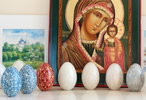The Metaphor of the Hare
When Ivan opens the casket, a hare leaps out. If we try to un pack that, we’ll find that we’ve forgotten most of what our ancestors felt and thought about the hare. The hare carried, one might say, an enormous amount of meaning to ancient people, and the meaning was basically that of sacrifice.
Some dreams recorded in this century reveal very clearly the associations around the hare as they appeared to a modern woman. When the psychologist John Layard was living in En gland, just before the Second War, he accepted into therapy an Irish woman who was troubled over the behavior of her young daughter. The woman, Mrs. Wright, a Protestant who had an education in the elementary grades and no education in mythology, reported the following dream to Layard, who at the time knew nothing of the Hare-egg mythology himself:
"The scene is near my home in Ireland, and I am walk ing with Margaret up to a square house belonging to a female cousin whom I know very well. The ground was covered with snow'. Margaret was in a bit o f a fuss wanting to hurry up and get the place dusted, but I told her not to be in such a hurry, as in any case, with snow lying about, there wouldn’t be much dust. . . .
Then I went round alone into the kitchen at the back of the house. Inside there was a great light and every thing was as white as it was outside, though how' the snow' got in there I cannot tell.
There were people inside, too, and there, in a white bowl with a little water in it, was a live hare. Someone told me I had got to kill it. This seemed a terrible thing to do, but I had to do it. I picked up the knife (an ordinary kitchen knife) which seemed to have been placed ready for me and which was lying in the water inside the bowl beside the hare, and with a feeling of horror I started cutting into the fur through to the skin beneath. I had to cut the hare straight down the middle of the back, and I started to do this, but my hand trembled so much that, as I cut down, the knife slipped away from the straight line, and ended up by cutting obliquely into the hare’s haunch.
I felt awful doing this, but the hare never moved and did not seem to mind. Though the ground outside was covered with snow we had left no footmarks on it."
Several weeks later, Layard, who had in the meantime read a bit about animal sacrifice, had a conversation with Mrs. Wright.
" told her how in certain primitive religions the ani mal was always sacrified before being eaten, and was himself at the same time the willing sacrifice, just as the hare had been. She then told me o f the look o f extreme satisfaction and trust that had been in the hare’s eyes as it looked back at her when she plunged the knife into its back. This made her think of Christ.2"
Many themes intertwine in Mrs. Wright’s dream. We remember the detail of moonlight coming off the snow, though the strange light is also inside the house. That suggests some sort of sacred space. The hare’s association with water comes in, and the connection of the hare with the moon. We recall the folk idea that we can see an outline of the hare on the moon. Finally, we notice that the hare in Mrs. Wright’s dream carried to her the motif of willing sacrifice.
All these motifs we see repeated in the mythology of many other cultures. A favorite theme in Japanese art is the moon goddess Gwatten, who is shown holding out to priests a dish that is actually a small crescent moon. Inside that dish a white hare is calmly seated, as if it were presented for sacrifice.
In European mythology, the hare is "the moon’s own magical love-creature.”3 The hare in many cultures is the mythical animal associated with the menstrual cycle. The moon, one could say, sends down an egg into the fallopian tubes once each month, first on the left side of the womb, next on the right side. The moon accomplishes all this.
The Ojibway call the moon the eye of the hare. We recall that the Nanzibojo, the Great Hare, is the hero of an Algonquin myth cycle. The hare has an association with immortality, which we would suspect already from Mrs. Wright’s dream of mysterious light. The hare is shown in China pounding up the herbs of immortality on the moon.
What shall we say, then, about the hare stage of our story? If we look at dictionaries of symbols, we will find the hare, as Mrs. Wright intuited in her dream, associated everywhere with the practice of sacrifice. It is associated with giving up things, letting parts of oneself go, offering something dear to a divinity, not necessarily in order to receive a boon in return, but rather as evidence that you are serious, that you want a change, that you understand that just because you have some object doesn’t mean you own it, that you are willing out of gratitude to the spirits and to the universe to give it away. Monks and nuns sacrifice their sexuality—at least, intend to. T. S. Eliot mentions that the writer’s life amounts to “a daily crucifixion” because of the sensual life he has to abandon in order to write well. Often a therapist will ask for a sacrifice: I want you to turn off the television for three months, I want you to work Saturdays in a homeless shelter, I want you to come home from work at five every day, and give those evening hours to your children.
Many people feel that women mature emotionally at an earlier age than men because a woman can be said to sacrifice her blood every month, and she is aware how much she will sacrifice if a baby comes. Some say that the male has to intend to become an adult. A writer on myth recently wrote:
"I remember reading what seemed to me a beautiful re mark made by one of the men in the Mandan tribe, a tribe up in Missouri. George Catlin, a young painter, went out from Harvard in 1832 and painted pictures of these Indians and the magnificence of their ritual and so forth. The young men who were hung up by spikes through their pectoral muscles and beaten said, “We have to learn to suffer in order to compensate for the suffering of our women.” Life brings the suffering on the woman, and the man has to match it by imposing suffering on himself."
Sacrifice, then, implies willing sacrifice—we are not talking here about unwilling sacrifice of victims. So the stage of Ivan’s search that is described metaphorically as a hare leaping out of the coffer brings up willing sacrifice. Goethe’s great poem called “Holy Longing” sums up the mood of such willing sacrifice:
Tell a wise person, or else keep silent,
Because the massman will mock it right away. I praise what is truly alive,
What longs to be burned to death.
In the calm water of the love-nights,
Where you were begotten, where you have begotten,
A strange feeling comes over you
When you see the silent candle burning.
Now you are no longer caught
In the obsession with darkness,
And a desire for higher love-making Sweeps you upward.
Distance does not make you falter; Now, arriving in magic, flying,
And, finally, insane for the light,
You are the butterfly and you are gone.
And so long as you haven’t experienced This: to die and so to grow,
You are only a troubled guest
On the dark earth.4
(Translated by R.B.)
So the third stage implies an offering of oneself.





